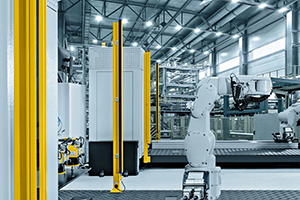
Posted to News on 3rd Nov 2021, 00:00
Choosing and using safety light curtains – all you need to know
There is a huge variety of safety light curtains and light barriers to choose from, but which of these suits your machine or application best? We asked the experts at OEM Automatic for guidance.

Light curtains or light barriers, also often referred to as safety light curtains, are photoelectric safety devices which provide protection from hazardous machinery and are capable of monitoring large areas. Light curtains consist of a transmitter and receiver. From the transmitter, infrared beams are transmitted to the receiver. When one or more of the light beams are interrupted, a dual output stop signal is given to stop the dangerous action of the machine.
The dual output signal consists of two separate output signal switch devices (OSSD)s, ie two failsafe 24V DC outputs. These outputs are short-circuit monitored.
There are different systems to choose from depending on the function and requirements of your application. The safety requirements are set in international standards, and there are different levels of security depending on the type of risk. Machine designers should look to use of light curtains or light barriers:
- When there is a need for continuous access to an area of risk, for example loading/unloading of manually operated machines
- When you need to secure large areas around hazardous machinery
- For continuous goods passage (such as a pallet of goods on a conveyor)
- For machine safeguarding and access control in dangerous areas
A light curtain has multiple light beams, which makes it ideal for the detection of small objects such as fingers or hands. The resolution of the safety light curtains relates to how close the light beams are together. A light curtain with a 14mm resolution is designed to detect fingers, while a 30mm resolution is to detect hands or larger parts of the body.
Pedestrian access light curtains are usually two, three or four beams.
Safety functions
Bypass ‘mute’: In some applications and automatic processes, for practical reasons, it may be necessary to disconnect the safety function of the light shield. The use of a mute on light protection requires a risk assessment of the machine to find out if there are any risks with bypassing the light protection. Bypass can be used in the following circumstances:
- Material that affects light protection when input or output in the automatic process
- Material handling requires the operator to be positioned so that the light protection is affected
- The machine is in safe position
To achieve safety, a duplicated and monitored bypass system with at least two mutually independent signals is required. The performance level of the safety-related parts that make up the muting function shall be selected so that the introduction of the muting function does not lower the required safety level for the relevant protection function.
Manual start function: When a light barrier or light curtain is broken, a stop signal is given to dangerous machines within the risk area and a reset light comes on. To restart the machine, the light bar/curtain must first be reset. This is done with a reset button that must be positioned so that it cannot be reached from inside the protected area.
Great demands are placed on the reset function. That is, neither a short circuit nor component failure must provide automatic reset. When the reset button has been activated, the outputs are activated and the reset light goes out. Note that resetting the safety circuit should only allow the machine to be restarted.
Fixed/floating blanking: Blanking makes it possible to disconnect one or more beams from the protection field of the light shield. The purpose of this is to allow the likes of tools and material feeds pass the protective field without sending a stop signal to the machine.
In ‘fixed blanking’ the object cannot move in the protection field, but the same beams must be blocked at all times. Floating blanking makes it possible to disconnect up to three beams from the protective field. The object can then move in the protective field without a stop signal being sent to the machine.
Note that it is important to keep in mind that the resolution will be higher and that you must recalculate the protection distance.
Mute enable: This acts as a third muting signal – in other words, a signal that enables muting. This function can be good to use in transport paths when connected to the motor contactor. When the track goes, a signal is given to the light protection that muting is possible. In this way, it is difficult to manipulate the protection and to enter a dangerous area.
External device monitoring: For something like external contactor monitoring, an NC contact from the contactor is connected via 24V to a dedicated input on the light curtain. The light curtain cannot then be reset if one or more contactors have welded.
Override: This function makes it possible to temporarily drive the safe outputs of the light protection for a fixed period of time to a ‘mutated’ position even when one or more safe beams are blocked due to errors in the muting sequence.
Suppose, for example, a pallet gets stuck in the protection field, whereby the safe exits are broken and a stop signal is given. As long as the pallet blocks the protection field, it is not possible to reset the light protection. Activation of the Override function enables the reestablishment of the light protection
Cascade coupling: By cascade connection, what is meant is that you can connect several units in series. You always start from a master that is connected in the safety circuit and the so-called slave is controlled by the master. A typical application is the so-called ‘L’ variant.
OEM Automatic offers a wide range of safety light curtains from Datalogic from machine safeguarding and access control in dangerous areas, with basic and advanced functions such as integrated muting, override, blanking, cascadeable and configurable modes.








